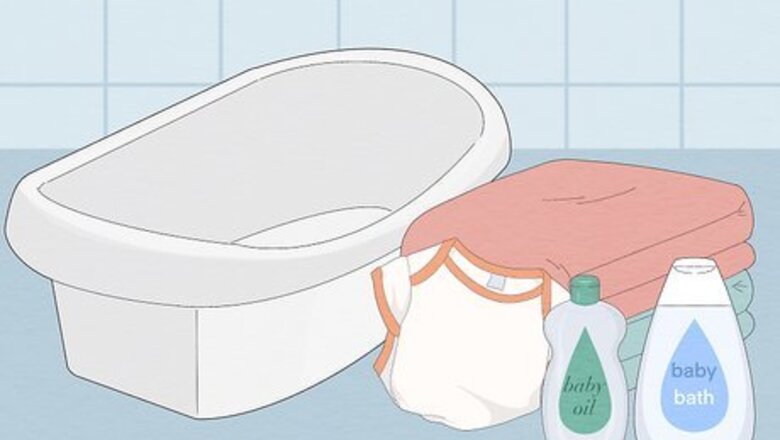
views
Preparing for Bath Time
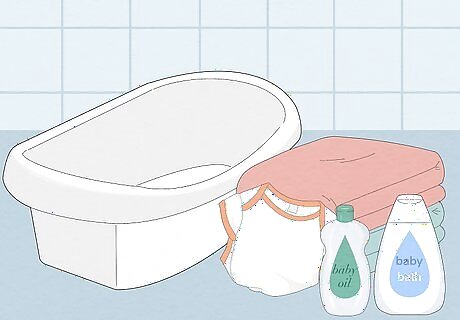
Get everything ready in advance. Once the baby is in the bath, you won't be able to leave them for even a moment, so it's important to set out everything you need before you begin. Gather what you need for the bath itself, including the tub, a cup for pouring water, gentle baby soap, two washcloths, and cotton balls for cleaning the baby's eyes and ears. Optionally, collect a few bath toys for the baby to play with. Lay out what you'll need after the bath, including a towel, a brush or comb, lotion or oil, a diaper, diaper ointment and a clean set of clothes nearby. Until the umbilical cord has fallen off, sponge bathes are probably the easiest way to wash the baby because dry cord care is currently recommended--just leaving the stump alone to let it fall by itself. Despite what you have heard, there is no need to use rubbing alcohol to clean baby's umbilical cord area if it is still attached.
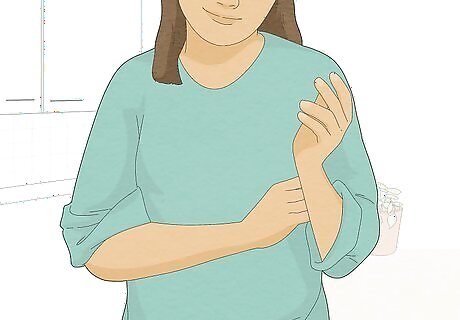
Dress in appropriate clothes. Wear something you don't mind getting wet and soapy. Roll up long sleeves, and remove jewelry like watches, rings, and bracelets. Make sure your clothes don't have zippers or pins that could scratch the baby's skin. Many caregivers like wearing a terrycloth bathrobe while bathing a baby.
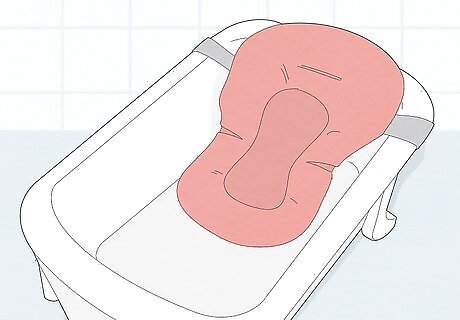
Set up the tub. Most baby tubs available are shaped so as to support the infant's neck and head. They usually have a mat or sling that prevents the baby from being completely submerged in water. Place the baby bath in a clean sink, bathtub, or on the floor, depending on the manufacturer's instructions. If you don't have a baby bath, you may use a clean kitchen sink instead. Just make sure the tap does not touch the baby's head. Tap covers are available for baby-proofing your sink. Do not use a full-size adult bathtub to bathe a newborn baby. They are too deep, and it's difficult to make sure the baby doesn't slip during the bath. If your baby bath doesn't have a tread on the bottom to keep the baby from slipping, line it with a washcloth or separate bath mat.
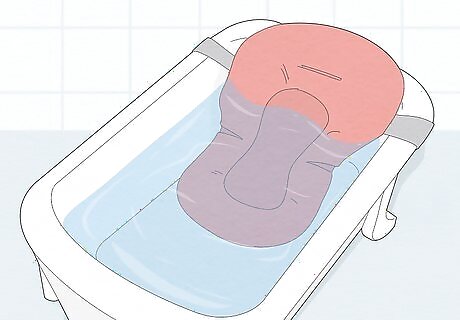
Fill the tub with a few inches of warm water. Run the water and test the temperature. You may use your elbow, wrist or a special bath thermometer to make sure the water isn't too hot or cold for the baby. The water should be comfortably warm to the touch, but not as hot as you'd prefer for your own bath or shower. If the baby still has their umbilical cord attached, simply fill a bowl with water so you can administer a sponge bath instead. Always test the water before placing the baby in the bath. When in doubt, err on the cooler side; your hands are rougher than a baby's sensitive skin, so they will feel heat more acutely than you. Do not fill the tub more than a couple of inches. Babies should never be submerged in water. As your baby gets a little bigger, you can add a bit more water, but never enough to come close to submerging the baby.
Bathing Your Baby
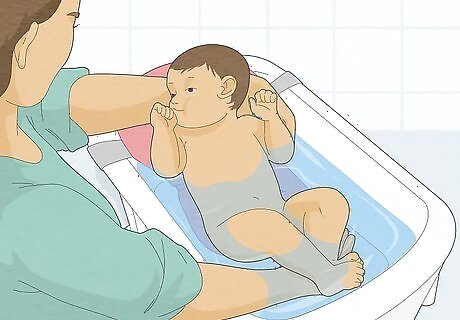
Lay your baby in the tub feet first. Keep one hand supporting the baby's back, neck and head as you carefully lower them into the tub. Continue supporting the baby throughout the bath with one hand, and use the other hand to wash them. Babies can be very wriggly and slippery, so be very careful once they become wet.
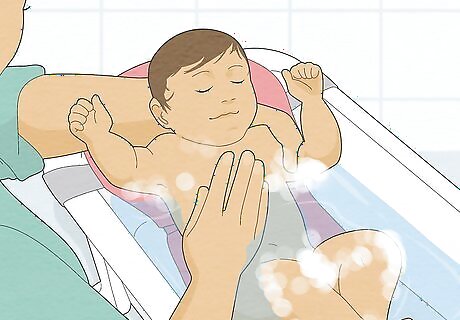
Begin washing the baby. Use a cup, or your cupped hand, to get the baby's body wet. Use a soft washcloth to gently wash the baby's face, body, arms and legs. Use cotton balls to wipe the baby's eyes and ears. If you wish, you can use a safe baby soap that is very neutral, but it isn't necessary; a gentle scrub and wash down are adequate to keep babies clean. Don't forget to get between all the little creases and behind the ears and under the neck, where spit-up and moisture tend to collect. Use a little baby soap on a washcloth to wash the baby's hands and feet. Clean the baby's genitals last, using a dab of baby soap if you wish. If you have a baby who is circumcised, gently wipe them with the wet washcloth. Wash female babies from front to back to prevent infection.
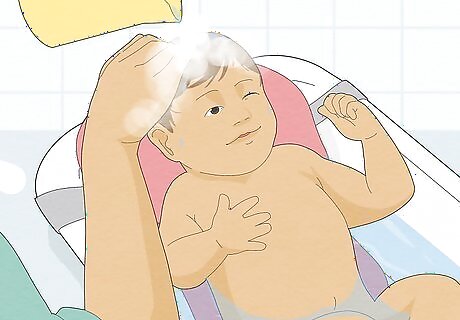
Wash the hair. If it is necessary to wash the baby's hair, lean them back and gently massage water into the hair and scalp. Use the cup to pour clean water over the baby's head. You can use baby shampoo if desired, but there is really no need. Babies are born with all the natural oils needed to keep the scalp healthy, and shampoos can easily spoil this balance. If you use baby shampoo, use your hand to protect the baby's eyes from being irritated. Before rinsing, check again to make sure that the temperature of the running water is not too hot.
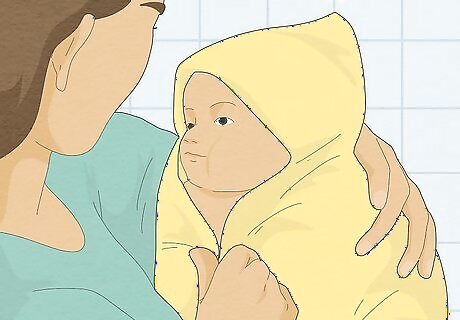
Lift the baby from the tub. Support the baby's head, neck, and back with one arm, and hold their bottom and thigh with the other. Place baby in a towel, being careful to cover their head.
After the Bath
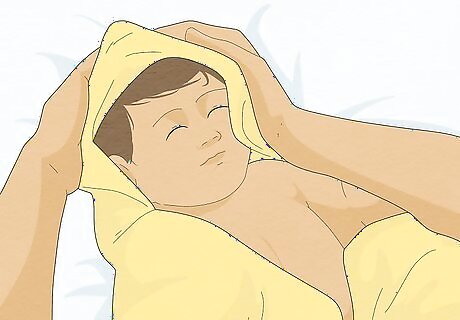
Towel the baby dry. Dry the baby's body first, making sure to dry gently behind the ears and in the skin folds, so that no excess moisture is left there. Towel-dry the hair as much as possible. Remember that the fine hair of a baby will dry quickly. Do not use a hairdryer, as it is unnecessary and potentially dangerous.
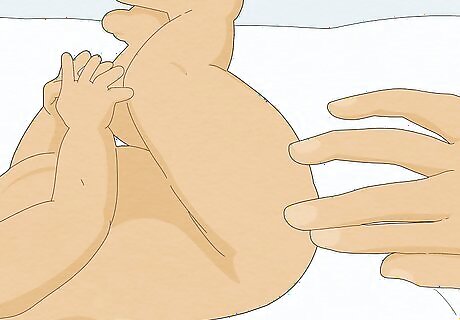
Apply ointments if necessary. Dab a little ointment on the baby's diaper rash or circumcision wound if you've been advised to by a doctor. It's OK to apply baby creams, lotions, or oils if you'd like, but these are unnecessary. If the baby still has their umbilical cord attached, use a cotton ball or dry sponge to gentle dry the area. No need to use rubbing alcohol.
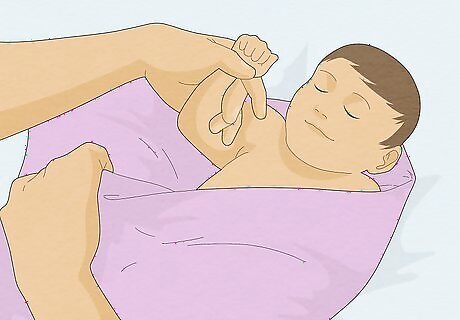
Put a nappy on and dress the baby. If you're about to put your little one down to rest, choose an outfit that's easy to fit on them, preferably with snaps instead of buttons. You may also choose to swaddle the baby (see How to Swaddle a Baby for more information).












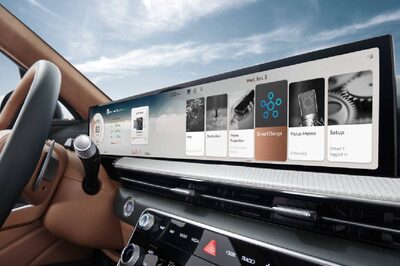




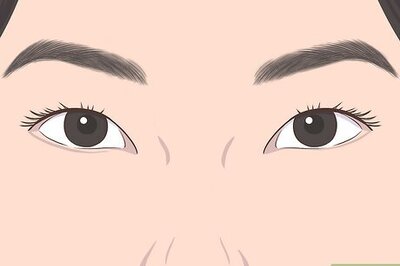

Comments
0 comment